Growing up near Pampanga, Burong Hipon was always that irresistible temptation that my grandmother's kitchen turned out twice a month.
Despite my shrimp allergy, I couldn't help but sneak small spoonfuls of this umami-rich fermented delight every time my Lola Norma made a fresh batch. I still remember her saying "Anak, bawal sa'yo yan!" with a mix of concern and amusement as I dipped my crispy eggplant into the savory sauce.
The secret of this traditional condiment lies in its perfect balance of salty, slightly sweet, and spicy flavors that transform even the simplest fried fish or steamed vegetables into something extraordinary.
Let me share with you our family's authentic Burong Hipon recipe, passed down through generations of Kapampangan cooks.
While the 14-day fermentation process might seem daunting at first, I promise it's worth every minute of waiting. This recipe creates that same deep, complex flavor that made me risk my allergies as a child - though I definitely don't recommend that!
Jump to:
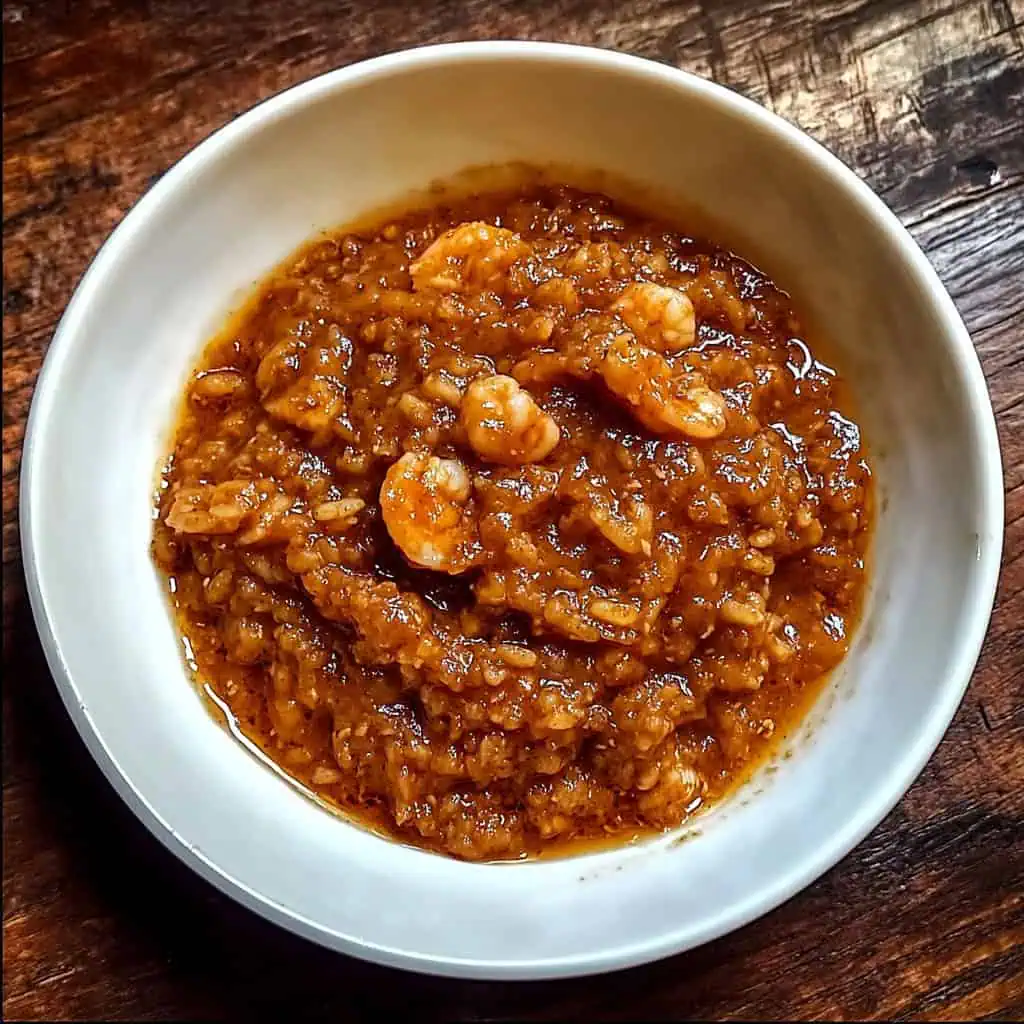
Why You'll Love This Recipe
- Authentic Kapampangan Heritage: Experience a true taste of Pampanga's culinary tradition
- Versatile Condiment: Enhances both fried and boiled dishes
- Long Shelf Life: Keeps well for up to a month when properly stored
- Cost-Effective: Makes a large batch that lasts several weeks
- Umami-Rich: Develops complex, savory flavors through fermentation
- Zero-Waste: Uses whole shrimp, making it environmentally friendly
Ingredients
The ingredients in Burong Hipon work together to create a perfect balance of flavors and textures. Fresh shrimp provides the base protein and umami flavor, while their shells contribute essential minerals that aid fermentation.
Rock salt not only preserves the mixture but draws out moisture from the shrimp, creating the flavorful brine. Brown sugar balances the saltiness and feeds the fermentation process, while chili powder adds warmth without overwhelming heat. The slightly overcooked rice serves as both a thickening agent and fermentation medium, providing carbohydrates for beneficial bacteria to thrive.
During cooking, aromatic ingredients like ginger, garlic, and onions add layers of flavor complexity, transforming what started as a simple preservation method into a rich, savory condiment that elevates any dish it accompanies.
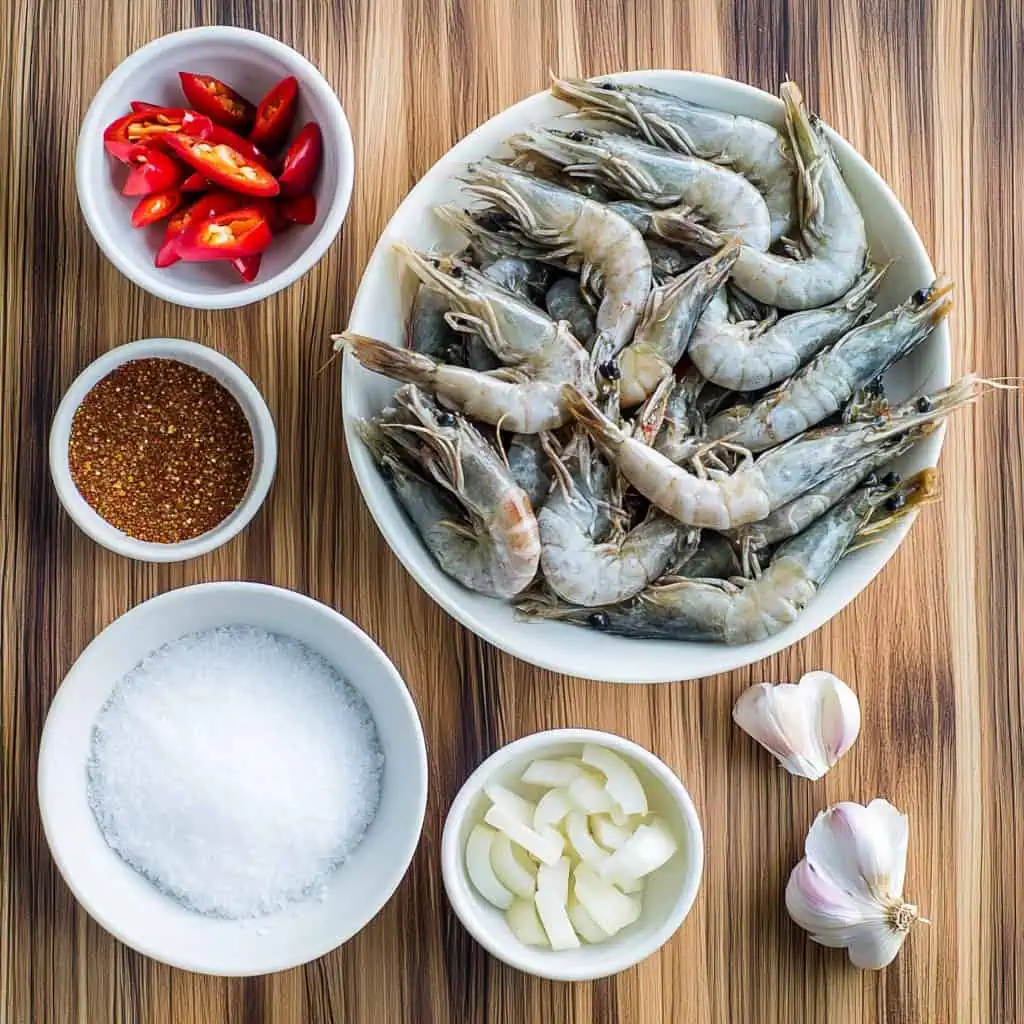
For Shrimp Marinade:
- 2 cups fresh shrimp
- ¼ cup rock salt
- 2 tablespoons brown sugar
- 3 tablespoons chili powder
For Base:
- 5 cups cooked rice, slightly overcooked
For Cooking:
- 6 cups fermented rice and shrimp mixture
- 1 cup olive oil
- ⅓ cup minced ginger
- ⅓ cup minced garlic
- 1 tablespoon minced red chili pepper
- 1 cup minced onions
- 2 cups water
Equipment Needed
- 2 Medium Sterilized Glass Jars (1L each): Essential for the fermentation process, ensuring no harmful bacteria interfere with the fermentation.
- Digital Kitchen Thermometer: Helps monitor fermentation temperature, keeping it at the optimal range for successful results.
- Large Wok or Heavy-Bottom Pan: Provides even heat distribution for the final cooking stage, preventing burning.
- Rice Cooker: For preparing the slightly overcooked rice base, which feeds the fermentation process.
- Wooden Spoon: Used for mixing ingredients to avoid introducing metallic flavors.
- Fine-Mesh Strainer: Helps thoroughly clean the shrimp while allowing water to drain properly.
- Sharp Knife: For precisely cutting ingredients, especially when preparing the shrimp.
- Toothpicks: Used for the delicate process of deveining shrimp without damaging the shells.
- Clean Cotton Cloth: Covers fermentation jars while allowing slight air circulation.
- Measuring Cups and Spoons: Ensures accurate measurements for consistent results.
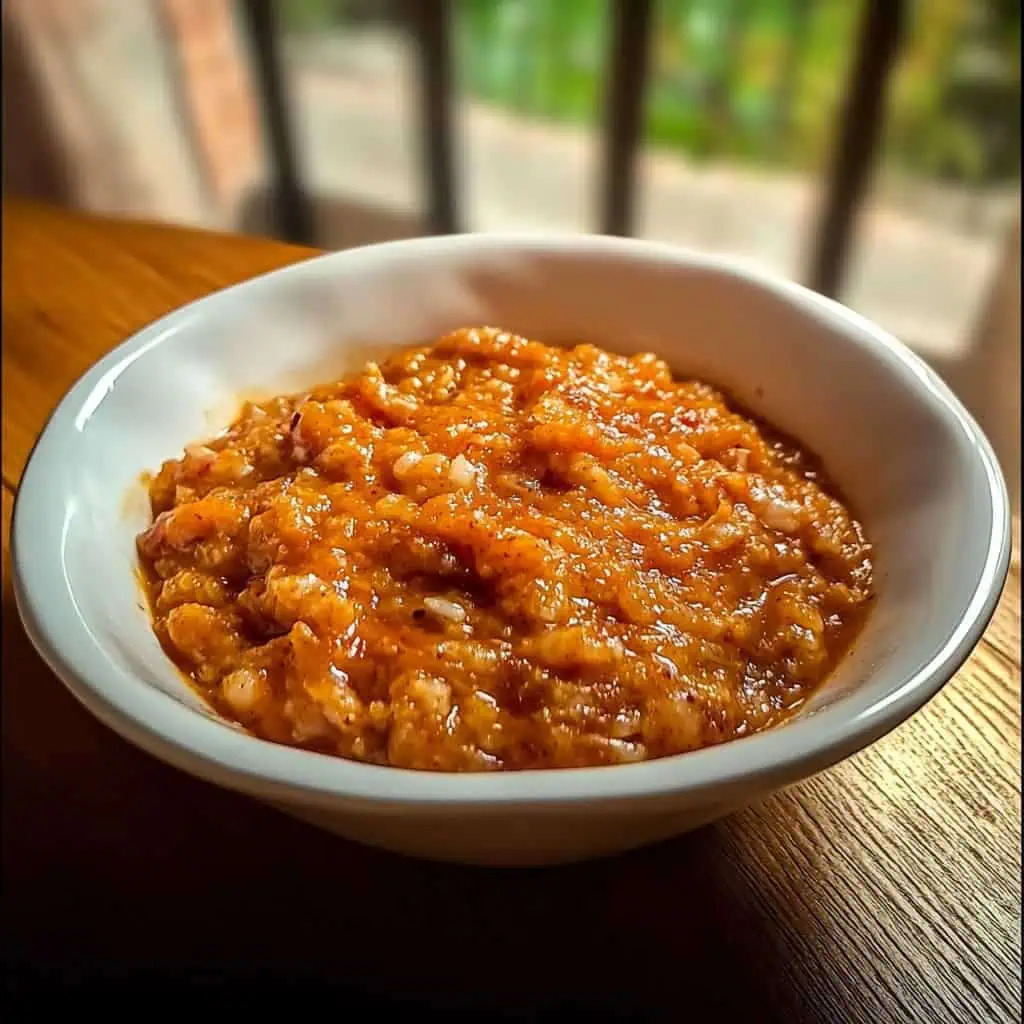
How To Make
- Sterilize your glass jars by boiling them in water for 10 minutes. Let them cool completely.
- Clean the fresh shrimp by removing the heads, tails, and legs. Keep the shells on. Using a toothpick, remove the black vein from the back of each shrimp. Cut each shrimp into 2-3 pieces.
- Put the chopped shrimp in a bowl. Add rock salt, brown sugar, and chili powder. Mix everything well, gently pressing the shrimp to absorb the seasonings. Cover and let it marinate for 1 hour.
- Cook your rice with extra water than usual - you want it slightly softer than normal rice. Spread the cooked rice on a tray and let it cool completely.
- Mix the cooled rice and marinated shrimp in a large bowl until well combined.
- Pack this mixture into your sterilized jars, filling up to the neck. Press down firmly to remove air pockets. Wipe the jar rims clean with paper towels. Place plastic wrap on top of each jar before closing the lids tightly.
- Store the jars in a dark cabinet at room temperature for 7 days. After a week, you should see liquid at the bottom of the jars. When you open them, they shouldn't smell bad.
- After checking, mix the contents with a clean spoon, close the jars tightly, and return them to the dark cabinet for another 7 days.
- After the full 14 days, heat olive oil in a large pan. Cook minced ginger, garlic, and onions until soft and fragrant.
- Add your fermented shrimp mixture and bring to a boil while stirring for 5 minutes.
- Pour in the water and reduce heat to medium. Let it simmer for 40 minutes, stirring occasionally until it reaches your desired thickness.
- Turn off the heat and let it cool slightly. Transfer to clean jars for storage and keep in the refrigerator, where it will last for 30 days.
- Serve as a sauce with fried eggplant, vegetables, or fish. Always use a clean spoon when serving.

Tips from Lola's Kitchen
- Use the freshest shrimp possible: The quality of your shrimp directly impacts the final flavor. Fresh shrimp have a sweet, clean taste that ferments beautifully without any off-flavors.
- Never remove the shells: Contrary to what you might think, the shells become tender during fermentation and contribute significantly to the complex flavor profile. They also contain natural minerals that aid in proper fermentation.
- Temperature matters: Fermentation works best between 75-85°F (24-29°C). Too cold and fermentation slows down; too hot and you risk spoilage. Use your kitchen thermometer to check occasionally.
- Trust your nose: A properly fermenting batch should smell pleasantly sour, similar to sauerkraut or kimchi. Any smell of rotting or ammonia means contamination.
- Patience pays off: Resist the urge to cut the fermentation time short. The full 14 days allows beneficial bacteria to develop complex flavors while ensuring food safety.
- Mixing at 7 days: This crucial step redistributes the salt and equalizes the fermentation process throughout the jar. Don't skip this step!
- Cook thoroughly: The final cooking process not only develops flavor but also ensures food safety by killing any harmful bacteria that might be present.
- Use clean utensils: Always use freshly washed utensils when checking or serving to prevent introducing contaminants.
Substitutions
- Rock salt → Sea salt: Reduce the amount by 25% as sea salt is typically more potent than rock salt.
- Olive oil → Coconut oil or vegetable oil: Coconut oil adds a tropical note that works well with the flavor profile, while neutral vegetable oil lets the fermented flavors shine.
- Fresh chili → Dried chili flakes: Use 2 tablespoons of dried flakes to replace 1 tablespoon of fresh minced chili.
- Brown sugar → Palm sugar or coconut sugar: These traditional Filipino sweeteners add an authentic touch and complex sweetness.
- White rice → Glutinous rice: For a thicker, more luscious texture, replace up to half of the regular rice with glutinous rice.
Troubleshooting
- Mixture smells foul or has mold: Unfortunately, this indicates contamination, and you should discard the batch. Ensure all equipment is properly sterilized next time.
- No liquid appearing after 7 days: Your fermentation environment might be too cold. Move to a slightly warmer location, but not near direct heat sources.
- Too salty after fermentation: Add more cooked rice when cooking the final mixture to dilute the saltiness while maintaining texture.
- Too thick after cooking: Gradually add hot water while stirring until you reach your desired consistency. Add just ¼ cup at a time.
- Too thin after cooking: Continue simmering uncovered to reduce excess liquid, stirring frequently to prevent burning.
- Not spicy enough: Add freshly minced chili during the final cooking stage to boost heat without affecting the fermentation.
Storage & Reheating
- Proper storage containers: Always use thoroughly cleaned glass jars with tight-fitting lids for storage.
- Refrigeration is essential: After the final cooking process, refrigeration stops further fermentation and preserves both flavor and safety.
- Shelf life: Properly prepared and refrigerated Burong Hipon will last up to 30 days. Look for signs of spoilage before using.
- Serving temperature: For best flavor, bring to room temperature before serving. The cold dulls the complex flavors.
- Reheating small portions: If you prefer it warm, reheat only what you'll consume immediately in a small pan over low heat until just warmed through.
- Avoid cross-contamination: Always use clean, dry utensils when serving to prevent introducing bacteria that could shorten shelf life.
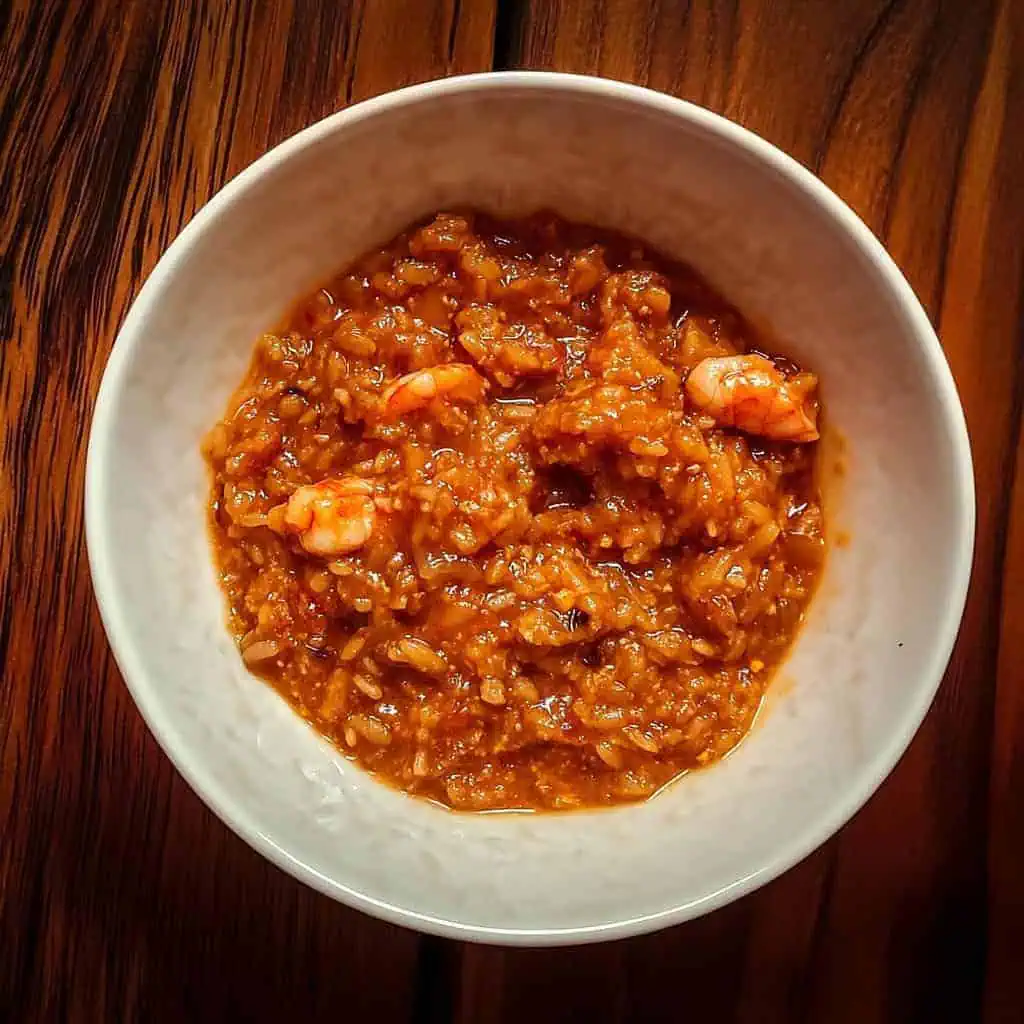
FAQ
Can I use frozen shrimp?
Fresh is preferred, but frozen can work if thoroughly thawed and patted dry. The flavor might be slightly less intense, but still delicious.
Why keep the shells on the shrimp?
Shells contain flavor compounds and calcium that become tender during fermentation. They add depth of flavor and beneficial minerals for fermentation.
Can I reduce the fermentation time?
Not recommended - proper fermentation ensures both safety and flavor development. Shortcuts may result in underdeveloped flavor or potential safety issues.
How do I know if my Burong Hipon has spoiled?
Discard if you notice mold, offensive odors (beyond the normal fermented smell), or unusual colors like blue, green, or black spots.
Can I make a smaller batch?
Yes, maintain the same ratios and use smaller jars. The process remains the same, though smaller batches might ferment slightly faster.
Is this safe to eat without cooking?
No, the final cooking process is crucial for food safety. Always complete the full cooking procedure before consuming.
Can I give this as a gift?
Yes! Package in sterilized jars, include refrigeration instructions, and recommend consuming within two weeks for best quality.
Why is my Burong Hipon different in color from others I've seen?
Color variations are normal and depend on the specific shrimp, chili quantity, and cooking time. Colors can range from pinkish-orange to deep reddish-brown.
Can I add other spices or ingredients?
Once you master the basic recipe, feel free to experiment with additions like lemongrass, kaffir lime leaves, or even a splash of fish sauce for extra depth.
Related
Looking for other recipes like this? Try these:

Burong Hipon (Tagilo/Balao-balao)
Equipment
- 2 Medium Sterilized Glass Jars (1L each) For fermentation process
- Digital Kitchen Thermometer To monitor fermentation temperature
- Large Wok or Heavy-Bottom Pan For final cooking
- Rice cooker - For preparing the rice base
- Wooden spoon For mixing and stirring
- Fine-mesh strainer For washing shrimp
- Sharp knife For preparing ingredients
- Toothpicks For deveining shrimp
- Clean Cotton Cloth For covering jars during fermentation
- Measuring cups and spoons For accurate measurements
Ingredients
For Shrimp Marinade (Para sa Pagba-bagoong ng Hipon)
- 2 cups fresh shrimp sariwang hipon
- ¼ cup rock salt timpling asin
- 2 tablespoons brown sugar maskada
- 3 tablespoons chili powder pulbos na sili
For Base
- 5 cups cooked rice lutong kanin, slightly overcooked
For Cooking
- 6 cups fermented rice and shrimp mixture
- 1 cup olive oil langis ng oliba
- ⅓ cup minced ginger ginisang luya
- ⅓ cup minced garlic ginisang bawang
- 1 tablespoon minced red chili pepper ginisang siling labuyo
- 1 cup minced onions ginisang sibuyas
- 2 cups water tubig
Instructions
- Sterilize your glass jars by boiling them in water for 10 minutes. Let them cool completely.
- Clean the fresh shrimp by removing the heads, tails, and legs. Keep the shells on. Using a toothpick, remove the black vein from the back of each shrimp. Cut each shrimp into 2-3 pieces.
- Put the chopped shrimp in a bowl. Add rock salt, brown sugar, and chili powder. Mix everything well, gently pressing the shrimp to absorb the seasonings. Cover and let it marinate for 1 hour.
- Cook your rice with extra water than usual - you want it slightly softer than normal rice. Spread the cooked rice on a tray and let it cool completely.
- Mix the cooled rice and marinated shrimp in a large bowl until well combined.
- Pack this mixture into your sterilized jars, filling up to the neck. Press down firmly to remove air pockets. Wipe the jar rims clean with paper towels. Place plastic wrap on top of each jar before closing the lids tightly.
- Store the jars in a dark cabinet at room temperature for 7 days. After a week, you should see liquid at the bottom of the jars. When you open them, they shouldn't smell bad.
- After checking, mix the contents with a clean spoon, close the jars tightly, and return them to the dark cabinet for another 7 days.
- After the full 14 days, heat olive oil in a large pan. Cook minced ginger, garlic, and onions until soft and fragrant.
- Add your fermented shrimp mixture and bring to a boil while stirring for 5 minutes.
- Pour in the water and reduce heat to medium. Let it simmer for 40 minutes, stirring occasionally until it reaches your desired thickness.
- Turn off the heat and let it cool slightly. Transfer to clean jars for storage and keep in the refrigerator, where it will last for 30 days.
- Serve as a sauce with fried eggplant, vegetables, or fish. Always use a clean spoon when serving.
Tips from Lola's Kitchen
- Use freshest shrimp possible for best results
- Never remove shells - they add flavor and become tender
- Sterilize jars by boiling for 10 minutes
- Check fermentation daily for any unusual colors or smells
- Use wooden or plastic utensils to prevent metallic taste
- Store in a cabinet away from direct sunlight
- Mark your calendar for fermentation tracking
Nutrition
The Story Behind Burong Hipon (Tagilo/Balao-balao)
In the heart of Pampanga, known as the Culinary Capital of the Philippines, Burong Hipon stands as a testament to our ancestors' ingenuity in food preservation. This fermented shrimp and rice mixture, also known as Tagilo or Balao-balao, emerged from the province's rich fishing traditions and the Kapampangan's masterful understanding of fermentation.
Long before refrigeration reached Filipino homes, our resourceful ancestors developed this preservation technique to extend the shelf life of fresh shrimp catches from the rivers of Pampanga. The combination of salt, rice, and fermentation not only preserved the shrimp but also created an entirely new condiment that would become a cornerstone of Kapampangan cuisine. The addition of rice wasn't just for bulk – it provided the perfect environment for beneficial bacteria to create that distinctive umami flavor that we've come to love.
What makes Burong Hipon particularly special is how it reflects the Kapampangan principle of "zero waste" cooking. Unlike other shrimp preparations, this recipe uses the whole shrimp with shells intact, allowing them to become tender through fermentation while contributing to the depth of flavor. This practical approach to cooking has been passed down through generations, with each family adding their own subtle variations to the basic recipe.
Today, this humble fermented dish has evolved from a preservation method to a sought-after condiment that graces many Filipino tables. While every Kapampangan household claims to have the best recipe, they all agree on one thing: Burong Hipon is more than just a condiment – it's a cultural heritage that tells the story of Pampangan ingenuity, resourcefulness, and culinary excellence. Whether paired with crispy fried eggplant, fresh vegetables, or grilled fish, this fermented delicacy continues to be a proud symbol of Kapampangan cuisine, bridging the gap between ancient food preservation techniques and modern Filipino gastronomy.
In recent years, as interest in fermented foods and traditional preservation methods has surged worldwide, Burong Hipon has gained recognition beyond Pampanga's borders. Food enthusiasts and chefs are discovering what Kapampangans have known for generations – that this unique condiment adds an unmatched depth of flavor to any dish it accompanies. Its growing popularity has led to increased interest in preserving and documenting traditional preparation methods, ensuring that this culinary treasure continues to be enjoyed by future generations.
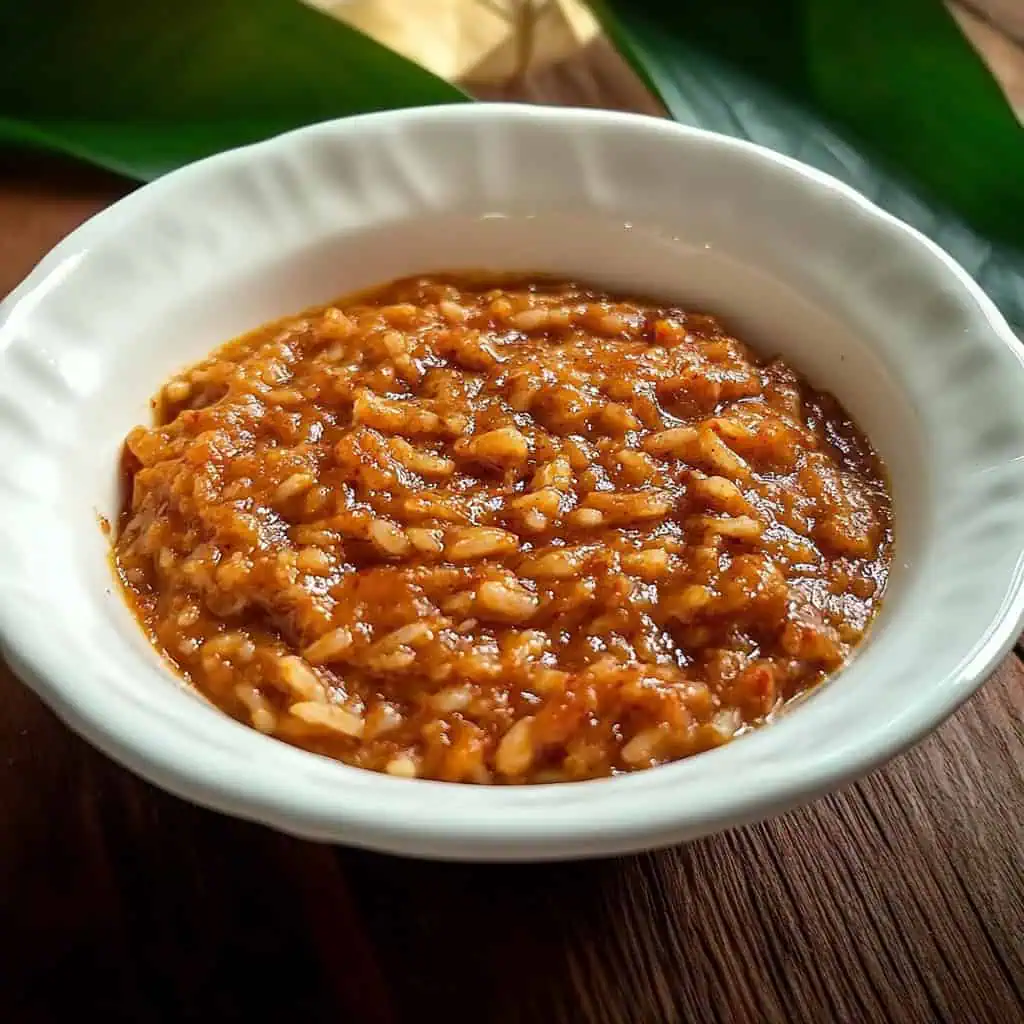





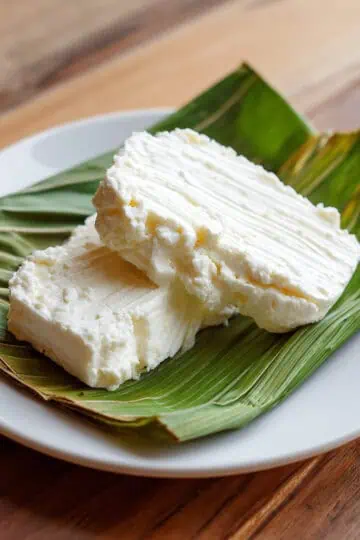
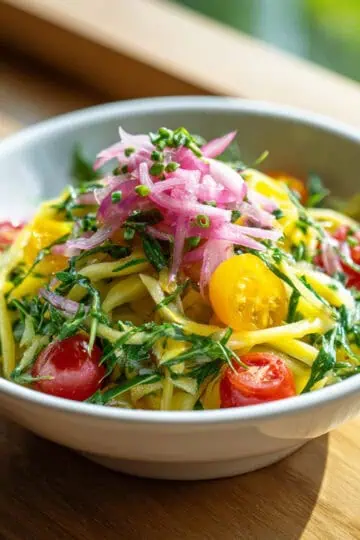

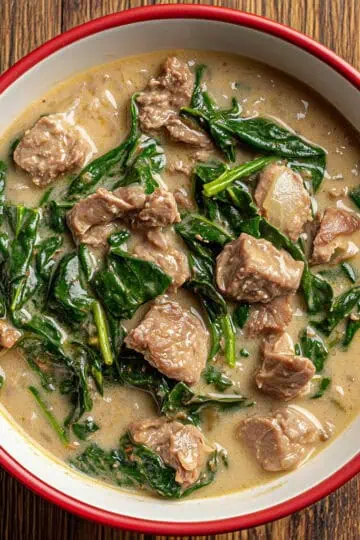
Comments
No Comments